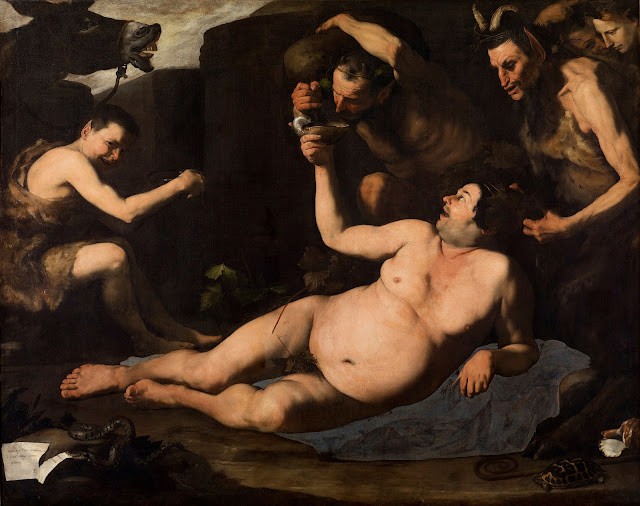 |
| Jusepe de Ribera Man with Turtles ca. 1615-16 oil on canvas Kunsthistorisches Museum, Vienna |
 |
| Jusepe de Ribera Hecate - Procession to a Witches' Sabbath ca. 1620 oil on copper Wellington Collection, Apsley House, London |
 |
| Jusepe de Ribera The Lamentation ca. 1620-25 oil on canvas National Gallery, London |
 |
| Jusepe de Ribera Drunken Silenus 1626 oil on canvas Museo di Capodimonte, Naples |
"When Caravaggio came to work in Naples in 1606-1607, the Mannerists were in full command of the situation, and he never swayed artists like Fabrizio Santafede, Gian Bernardino Assolino, Gerolamo Imparato, and Belisario Corenzio from their course; they continued their outmoded conventions, largely indebted to the Cavaliere d'Arpino, through the first half of the seventeenth century. The only exception to the rule was Giovanni Battista Caracciolo, called Battistello, the solitary founder of the 'modern' Neapolitan school who, in opposition to the Mannerists, developed his new manner based on the deeply felt experience of Caravaggio. . . . He had a younger rival in the Spaniard Jusepe de Ribera who, after journeys through Italy, settled in Naples in 1616 and soon painted Caravaggesque pictures utterly different from those of Caracciolo. While the latter hardened and stiffened the more flexible style of the master in an attempt at rendering internalized drama, the former loosened and externalized what he had learned from Caravaggio by an aggressive and vulgar realism and a painterly chiaroscuro with flickering light effects. Ribera found a powerful patron in the Duke of Osuna, the Viceroy of Naples, who appointed him court painter, and later viceroys and Neapolitan nobles were equally attracted by his art. It is an interesting phenomenon that Ribera's passionate and violent pictures satisfied the taste of the Neapolitan court society. What attracted them was probably the essentially Spanish sensual surface quality of Ribera's realism – his permanent contribution to European Seicento painting."
– Rudolf Wittkower, Art and Architecture in Italy 1600-1750, originally published in 1958, revised by Joseph Connors and Jennifer Montagu and reissued by Yale University Press in 1999
 |
| Jusepe de Ribera Christ among the Doctors ca. 1630 oil on canvas Kunsthistorisches Museum, Vienna |
 |
| Jusepe de Ribera Penitent St Peter ca. 1628-32 oil on canvas Art Institute of Chicago |
 |
| Jusepe de Ribera Martyrdom of St Bartholomew ca. 1626-32 oil on canvas Musée de Grenoble |
 |
| Jusepe de Ribera St Bartholomew 1651 oil on canvas Yale University Art Gallery |
 |
| Jusepe de Ribera St Bartholomew ca. 1633-35 oil on canvas Alte Pinakothek, Munich |
 |
| Jusepe de Ribera Heraclitus 1634 oil on canvas private collection |
 |
| Jusepe de Ribera Portrait of a Musician 1638 oil on canvas Toledo Museum of Art (Ohio) |
 |
| Jusepe de Ribera Jacob with the Flock of Laban ca. 1638 oil on canvas (trimmed on left side) National Gallery, London |
 |
| Jusepe de Ribera Penitent St Peter before 1652 oil on canvas Kunsthistorisches Museum, Vienna |
 |
| Jusepe de Ribera St Jerome ca. 1640 oil on canvas Harvard Art Museums |
 |
| Jusepe de Ribera The Hermit before 1652 oil on canvas Aberdeen Art Gallery |